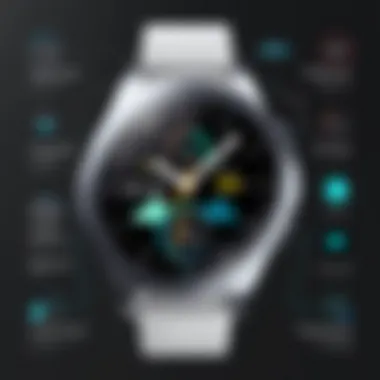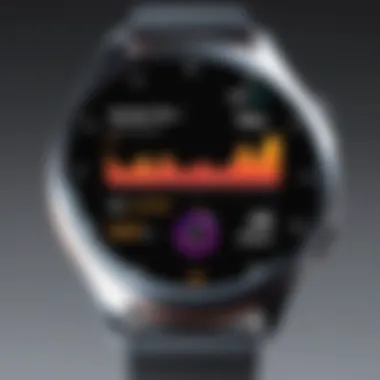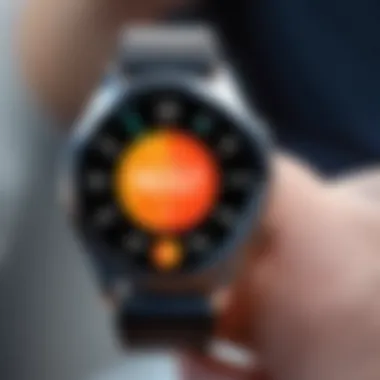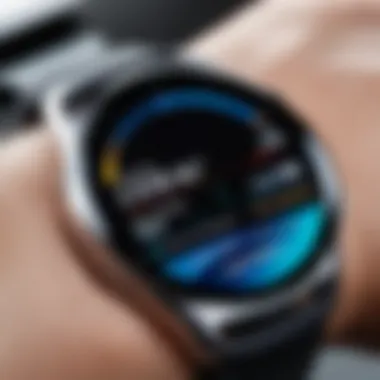Understanding VO2 Max Metrics on Samsung Galaxy Watch


Intro
Monitoring health metrics has become as intrinsic to fitness as lacing up a good pair of running shoes. With the surge of wearable technology, keeping track of vital signs and performance metrics is now at our fingertips. Among these metrics, VO2 max stands out as a pivotal indicator of cardiovascular fitness. The Samsung Galaxy Watch brings this metric into a user-friendly interface, allowing individuals to better understand their fitness levels and performance potential. In this piece, we'll explore the features and specifications of the Galaxy Watch that pertain to VO2 max, assess its performance and usability, and provide insights on how to effectively harness this data for fitness improvement.
Features and Specifications
Overview of Key Features
The Samsung Galaxy Watch boasts an array of features aimed at fitness enthusiasts and health-conscious users. Among these, the VO2 max tracking stands out prominently. Here are some highlighted features:
- Activity Tracking: Monitors various workouts such as running, cycling, swimming, and more.
- Heart Rate Monitoring: Continuously tracks heart rate variability, crucial for accurate VO2 max calculations.
- GPS Functionality: Provides precise distance measurements and routes during outdoor activities.
- Sleep Analysis: Collects data on sleep patterns, offering holistic insights into recovery and performance.
- Samsung Health Integration: Syncs seamlessly with the Samsung Health app for deeper analysis and long-term tracking.
Technical Specifications
When delving into the technical specs, the Galaxy Watch does not disappoint. It is equipped with:
- Processor: Efficient multi-core processor that ensures smooth operation during various applications.
- Display: A Super AMOLED display, vibrant and responsive, making it easy to read workout data.
- Battery Life: Lasts up to several days, depending on usage, alleviating concerns over frequent charging during intensive workouts.
- Water Resistance: IP68 rating that offers protection in various environments, important for swimmers and those exercising in the rain.
This combination of features and specifications ensure that users not only track their VO2 max but also gain insights from a broader set of health data that the watch collects.
Performance and User Experience
Real-World Performance
Practical testing of the Galaxy Watch in real-world conditions reveals how effectively it can deliver VO2 max metrics. Users have reported that during moderate to vigorous workouts, the readings align closely with more advanced equipment typically found in labs or gyms. However, one must keep in mind that while the Galaxy Watch is highly accurate, environmental factors such as temperature and user hydration can affect results.
Ease of Use
Ease of use is another significant aspect that deserves mention. The interface is intuitive, allowing users to navigate between metrics with relative ease. The touch screen is responsive, letting individuals quickly access VO2 max data without hassle. The setup process also stands out; users can easily configure their health metrics with guided prompts within the Samsung Health app, making the initial experience smooth.
"Understanding VO2 max can transform your fitness journey, offering insights that fuel tailored workouts."
Prologue to VO2 Max
VO2 Max, often touted as a gold standard in measuring an individual’s cardiovascular fitness, embodies the maximum amount of oxygen that one can utilize during intense exercise. This metric isn’t just a number; understanding it can serve as a cornerstone for athletes and fitness enthusiasts alike, providing insights into capabilities and areas for improvement. With the rapid advancements in wearables, particularly in devices like the Samsung Galaxy Watch, tracking this vital statistic has never been more accessible.
Definition and Significance
The term "VO2 Max" itself combines two critical components: the volume of oxygen (VO2) and maximum (Max). It quantifies how efficiently the body can transport and utilize oxygen during physical exertion. A high VO2 Max implies a strong cardio-respiratory system, enabling improved performance in endurance sports like running, cycling, and swimming.
Understanding one’s VO2 Max has profound implications for both health and training. It allows individuals to set tangible fitness goals based on precise metrics, adjust training intensities, and monitor progress over time. In essence, tracking VO2 Max can unlock a roadmap to better athletic performance and overall well-being.
VO2 Max and Health Indicators
VO2 Max is directly linked to various health indicators, making it a vital sign for assessing cardiovascular health. Numerous studies suggest a direct correlation between VO2 Max levels and mortality risk; the higher the VO2 Max, the lower the risk of heart-related health issues. This metric can act as an early warning system, highlighting potential fitness deficiencies before they escalate into more serious concerns.
Additionally, VO2 Max is often regarded as a proxy for aerobic endurance. Higher values not only signify better fitness levels but also correlate with enhanced metabolic efficiency and a more equipped body to handle physical stress.
Incorporating VO2 Max tracking into one’s fitness regimen, particularly using a sophisticated tool like the Samsung Galaxy Watch, can empower users to take charge of their health. As the watch aggregates this data, it not only helps craft personalized workout routines but also paves the way for informed lifestyle choices. The convergence of technology and fitness provides a framework not only for performance improvement but also for fostering long-term health benefits.
"VO2 Max isn't just a number; it's a gateway into understanding the boundaries of your physical endurance and overall health."
By keeping track of these metrics through an integrated device, users can experience a revolutionary shift in their approach to fitness. Understanding VO2 Max is key for anyone looking to tailor their training effectively, making it crucial to grasp its definition and implications thoroughly.
Overview of the Samsung Galaxy Watch
The Samsung Galaxy Watch stands out for its multi-functional capabilities, particularly when it comes to tracking VO2 max, an essential metric for understanding cardiovascular fitness. In the realm of wearable technology, this watch offers more than just a sleek design; it combines style with substance, making it a crucial tool for health-conscious individuals who want to elevate their fitness game.


Understanding the features of the Samsung Galaxy Watch can help users appreciate how this device fits into a healthy lifestyle. Not only does it gather data but it also analyzes it, providing insights that users can integrate into their training regimens. The compact design and user-friendly interface make it accessible to both seasoned athletes and casual fitness enthusiasts alike.
Design and Features
The Samsung Galaxy Watch boasts an elegant design that seamlessly integrates with various styles, making it a suitable wearable for both workout sessions and everyday use.
- Display: With a vibrant AMOLED screen, the watch provides clear visibility, even in bright sunlight. The clarity allows users to check their stats without squinting or straining their eyes.
- Customization Options: The ability to change watch faces and bands ensures that it aligns with individual styles, which is an attractive feature for many users.
- Durability: It's also worth mentioning its water and dust resistance, which adds longevity and resilience, especially during outdoor activities.
Moreover, the intuitive layout and responsive touch controls make accessing various functions a breeze. Users can easily swipe through different screens, selecting workouts or checking their heart rates without getting flustered.
Health and Fitness Tracking Capabilities
Health tracking is at the forefront of the Samsung Galaxy Watch's design, particularly in terms of VO2 max monitoring. This feature not only enables athletes to gauge their performance but also serves as a valuable indicator of overall cardiovascular health. The watch offers several capabilities:
- Pulse Oximetry: This function determines blood oxygen saturation levels, which plays a critical role in understanding how effectively the body utilizes oxygen during workouts.
- Heart Rate Monitoring: Continuous heart rate tracking is crucial for users aiming to optimize their training intensity. Being able to adjust efforts based on real-time data ensures workouts are neither too easy nor overly strenuous.
- Activity Tracker: From running to swimming, the watch tracks various activities, giving users a holistic view of their workouts and daily movements. The accumulation of data gives insights far beyond mere step counts.
- Integration with Fitness Apps: With compatibility across numerous fitness applications, users can sync their data more effectively. This integration enhances the viewing experience of VO2 max statistics and allows for comprehensive analysis over time.
"The ability of the Samsung Galaxy Watch to monitor VO2 max effectively sets it apart in the crowded field of fitness trackers. Its multi-faceted health features ensure a well-rounded approach to fitness tracking."
These tracking capabilities, combined with sleek design, position the Samsung Galaxy Watch as an indispensable ally for anyone serious about health and fitness. The integration of technology not only empowers users to set and reach personal fitness goals but also encourages them to maintain a healthier lifestyle overall.
VO2 Max Tracking on Samsung Galaxy Watch
VO2 max tracking on the Samsung Galaxy Watch offers a window into your cardiovascular fitness like no other tool available today. It’s more than just a fancy feature; it’s a gateway to understanding how efficiently your body uses oxygen during exercise. For those who prioritize fitness, keeping a close eye on this metric can translate to more effective workouts and better overall health outcomes. If you want to get the most out of your exercise routine, mastering VO2 max tracking is key.
How the Measurement Works
VO2 max is calculated through a series of algorithms that take real-time data from the watch’s sensors. The Galaxy Watch uses heart rate sensors in combination with motion tracking to estimate how much oxygen your body is consuming while exercising. When you engage in physical activity, the watch monitors your heart rate and estimates your oxygen consumption based on your movement patterns. The results are then expressed in milliliters of oxygen per minute per kilogram of body weight.
This method allows both beginners and seasoned athletes to gain insights into their fitness levels. An important note here is that while the measurements can be impressively accurate for a consumer-grade device, they are not a complete substitute for laboratory testing.
Data Collection Process
The process of data collection for VO2 max tracking isn’t just a one-off event; it’s ongoing and adaptive. First off, you need to make sure that the watch is securely fitted on your wrist. Once on, the watch will not only track your heart rate during your workouts but also gather baseline data during your day-to-day activities. This includes monitoring resting heart rate and activity levels over time.
After recording this data, the Samsung Galaxy Watch integrates it into its algorithms to provide you with a more personalized VO2 max reading. The more you use the watch, the better it gets at tailoring its feedback based on your specific fitness levels. Therefore, whether you are jogging at a steady pace or doing interval sprints, the watch captures this variability and refines its assessments.
- Key steps in data collection:
- Initial Setup: Make sure to input accurate personal data (age, weight, height) during setup.
- Activity Tracking: Engage in various workouts that change in intensity and type.
- Continuous Monitoring: Let the watch observe your daily activities to refine future readings.
"Continuous tracking is the backbone of accurate VO2 max data. The insights gained over time can guide your training decisions effectively."
Whether you're looking to improve your fitness level or just curious about your Cardio prowess, the Samsung Galaxy Watch simplifies the process, making it a valuable companion for fitness enthusiasts.*
Interpreting VO2 Max Data
Understanding how to read and interpret VO2 max data is crucial for anyone serious about tracking their fitness journey with the Samsung Galaxy Watch. This capability is not just a feature; it's an insight into your cardiovascular fitness and aerobic efficiency. When analyzing these metrics, you want to dive beyond the numbers. What do they mean for your health and fitness goals?
Understanding the Readings
At its core, VO2 max is a measure of how effectively your body can utilize oxygen during intense exercise. It's often presented in milliliters of oxygen per kilogram of body weight per minute (ml/kg/min). As you decipher this data, consider the following elements:
- Personal Benchmarks: Rather than only looking at the absolute value, it’s best to compare your results against standards for your age and gender. A 35-year-old male may have a different benchmark than a 25-year-old female. Knowing where you stand is the first step to improvement.
- Trends Over Time: Instead of fixating on a single reading, look for patterns. Over weeks or months, are you improving? If your VO2 max has consistently increased, that's a positive sign of enhanced aerobic fitness. Conversely, a decline might suggest the need to reassess your workout routine or health.
- Activity Correlation: Take note of how your VO2 max readings correlate with your training sessions. Did you push harder on your last run? Your reading might reflect that effort. Understanding these connections will help you tweak your workouts for optimal gains.
Don’t treat these numbers as an end-all. They are cues, not commandments.
Using VO2 Max Data for Fitness Goals


The analysis of VO2 max data doesn’t just end with understanding the readings; it opens the door to crafting effective fitness strategies. Here’s how you can leverage this information:
- Set Specific Targets: If your current VO2 max is 40 ml/kg/min and you aim for improvement, setting a target—say, 45 ml/kg/min—can provide clear motivation. This gives you a tangible goal to strive towards, making your progress measurable.
- Tailor Workouts: Use your VO2 max readings to customize your training. If your data indicates a low max level, incorporating high-intensity interval training or endurance sessions could be beneficial. This marks a turning point; you move from generic workout plans to personalized fitness regimens.
- Monitor Recovery: Your VO2 max can also reveal how well you recover from workouts. If you notice stagnation or a drop in your numbers, it might be an indication that your body isn't recovering adequately. Paying attention to rest periods, nutrition, and overall lifestyle will be key in this context.
"The freedom to personalize your journey translates data into understanding, making your fitness goals achievable."
The true power of VO2 max measurement lies in its ability to guide and inform your training. Using it effectively turns each workout session into a meaningful step towards achieving better health and performance.
Limitations of VO2 Max Measurement
Understanding the limitations of VO2 Max measurement is crucial for anyone serious about improving their fitness, especially those utilizing wearables like the Samsung Galaxy Watch. While VO2 Max is a valuable marker of cardiovascular fitness, it doesn’t paint the complete picture of one’s physical condition. Knowing these limitations helps users to better interpret their readings and not get carried away by the numbers alone.
Accuracy Concerns
When it comes to accuracy, the first thing that springs to mind is the method of estimation. The Samsung Galaxy Watch relies on heart rate data and algorithms to calculate VO2 Max, rather than the clinical tests that involve gas exchange analysis. According to research from various sources, including studies published on Britannica, the precision can vary significantly, sometimes swaying by several milliliters per minute.
We can’t ignore the infallibility of the technology itself. Like a clock that might tick tock a little off on some days, smartwatches can malfunction or misinterpret data, leading to skewed results. Factors such as the device's fit, external conditions like temperature, and even the user's skin tone can influence heart rate monitoring accuracy. Therefore, while the readings may give a ballpark figure, stressing over every minor change could be a road to frustration rather than motivation.
Contextual Factors Affecting Readings
Additionally, contextual factors play an undeniable role in affecting VO2 Max readings. Consider this: your state of hydration can drastically alter your performance. When you’re well-hydrated, your body operates like a finely-tuned machine, delivering oxygen efficiently throughout your system. However, dehydration can send those numbers reeling.
The wearer's fitness level cannot be discounted either. For instance, a seasoned athlete's heart rate could respond differently to physical strain than a casual runner. If both individuals were to race under similar conditions, their VO2 Max would illustrate vastly different values. It’s also important to keep in mind factors such as:
- Stress levels: High stress could affect heart rate and skew VO2 Max.
- Recent activity: One’s recent exercise and recovery may also impact the readings.
- Altitude and Environment: Training at high altitudes changes how your body consumes oxygen compared to lower areas.
"Understanding these nuances is not just about knowing your numbers; it's about grasping the story behind them."
Enhancing VO2 Max Performance
When it comes to improving cardio fitness, Enhancing VO2 Max Performance stands as a cornerstone. For users of the Samsung Galaxy Watch, this metric is not just a number; it’s a window into one’s cardiovascular health and athletic potential. Understanding how to improve it can mean the difference between merely exercising and truly optimizing fitness goals. This section will delve into strategies that can lead to noticeable enhancements in VO2 max, focusing on tailored workout routines and proper nutritional and recovery strategies.
Tailored Workout Routines
Creating a workout regimen that caters to one’s personal fitness levels and goals is crucial when aiming to boost VO2 max. A generalized approach often misses the mark, as fitness is deeply personal. Here’s a breakdown of how to forge effective routines:
- Interval Training: Incorporating bursts of high-intensity exercise followed by rest or lower intensity can drastically improve VO2 max. For example, running at a sprint pace for one minute followed by two minutes of walking can push the body to adapt, improving aerobic capacity faster than steady-state cardio alone.
- Fartlek Workouts: These are unstructured intervals, where the user varies the speed throughout the workout. It’s the versatility in pacing that makes this method effective. For instance, during a run, alternating between periods of fast running and moderate jogging can shock the body into better endurance.
- Long-Distance Cardio: While shorter bursts are great, longer sessions help build the overall stamina needed to enhance VO2 max. Aim for at least one session per week that lasts 60 minutes or more, mixing in different terrains and intensities for variety.
To ensure continued progress, it’s important that individuals track their routines. The Samsung Galaxy Watch offers real-time feedback and progress tracking, allowing users to adjust their workouts based on the data collected.
Nutrition and Recovery Strategies
What goes into the body can hold just as much weight as the workouts themselves. Proper nutrition and recovery play an intrinsic role in maximizing VO2 max. Here are some pointers to consider:
- Nutrient-Dense Foods: Maintaining a balanced diet rich in whole foods—fruits, vegetables, lean proteins, and whole grains—fuels workouts and aids recovery. Foods high in antioxidants, like berries and leafy greens, can help combat inflammation and improve performance.
- Hydration: Water, electrolyte drinks, and even herbal teas can keep the body functioning optimally. Dehydration negatively affects performance, so aim to drink adequate fluids before, during, and after exercising.
- Rest and Recovery: It can be tempting to focus solely on pushing limits, but recovery is where the body actually adapts and grows stronger. Incorporate rest days and gentle active recovery activities, such as yoga or strolling, to allow muscles to repair without losing fitness.
"One's body is a temple, and it requires both structure through training and nourishment to reach its potential."
In summary, combining tailored workouts with a diligent focus on nutrition and recovery strategies can significantly enhance VO2 max performance. The Samsung Galaxy Watch can serve as a reliable ally in this quest, providing insights and feedback every step of the way.
User Experience and Feedback
When it comes to wearable technology like the Samsung Galaxy Watch, the user experience can make or break how effectively one can utilize features such as VO2 max tracking. This section dives into just how crucial user experience is in this context, exploring specific elements that shape the overall satisfaction and functionality of the watch.
A seamless and intuitive interface is paramount. Users appreciate when the watch responds swiftly and provides clear metrics on their fitness journey. The way VO2 max data is presented can greatly influence how individuals interpret it. If the graphs and figures are too complex or buried under layers of menus, users may not engage with the data as often as they should. Important fitness indicators should be front and center, easily accessible at a glance.
Another aspect of user experience involves the feedback mechanisms embedded within the watch’s system. Alerts or suggestions based on the user’s performance can create a sense of accountability and motivation. For instance, if the watch notifies a user that their VO2 max has plateaued, it can prompt them to reassess their workout plan or engage in new activities to boost performance. This actionable feedback loops work to keep users engaged and invested in their health.


Moreover, the community aspect cannot be overlooked. Many users thrive on the social aspect of fitness tracking. There’s something inherently motivating about sharing achievements or competing with friends. This calls into the necessity for integrated social features that allow users to post their results and get feedback, creating a robust platform for interaction.
In summary, user experience affects how well one can engage with and derive benefits from VO2 max tracking. Elements like interface design, feedback mechanisms, and community interaction all play significant roles in shaping a satisfying user journey.
Real-world Applications
Looking into real-world applications, one cannot ignore how users leverage the VO2 max metrics offered by the Samsung Galaxy Watch to effectively tailor their fitness routines. For example, many individuals employ these measurements to decide whether or not to pursue endurance sports.
- Running enthusiasts often scan their VO2 max scores to gauge whether they are expanding their aerobic capacity, making important adjustments to their training accordingly. If, say, their scores have stagnated for a period, they might consider mixing in interval training to challenge their heart and lungs.
- Cyclists might also rely on VO2 max data to determine their stamina levels. If they aim to ride longer distances, the watch provides clarity on whether they are on track.
On the other hand, those just beginning their fitness journey can use their VO2 max metrics to set attainable goals. It's a measurable way to track improvements over time, altering their regimens as necessary to ensure continual advancement. In essence, quantifying one's fitness level provides not just a benchmark but also a motivational tool that can reshape personal exercise commitments.
Community Insights and Reviews
Diving into community insights, forums and social media platforms illustrate how users perceive the accuracy and usability of VO2 max tracking on the Samsung Galaxy Watch. Many users offer valuable feedback that reveals common misconceptions and highlights the value of real-time data.
- On platforms like Reddit, users swap tips and tricks, sharing stories that provide a collective wisdom about what works best with the watch. This type of insight often includes dos and don’ts related to VO2 max monitoring. For example, some users have suggested aligning the tracker with specific types of workouts to achieve the most accurate readings.
- Feedback often circles around the accuracy. If a user feels the reading isn’t lining up with their perceived effort or real-world performance, they tend to voice their concerns in a structured manner. This collective feedback often prompts software updates from Samsung, enabling the company to refine features based on user reports.
The community not only offers support but also fosters a sense of belonging among users, enhancing the overall experience. Social proof, in the form of shared reviews, can either bolster someone’s decision to invest in the technology or raise questions about its utility, thus making community engagement an essential element of user experience with the Samsung Galaxy Watch.
Future of VO2 Max Monitoring in Wearables
As technology continues to evolve, the future of VO2 max tracking in wearables is both exciting and complex. VO2 max, often viewed as the golden standard of cardiovascular fitness, is becoming more accessible through advanced wearable devices like the Samsung Galaxy Watch. This section aims to lay bare what lies ahead in this domain, exploring key elements such as improvements in accuracy, user experience, and what the addition of fresh technologies can mean for fitness enthusiasts.
Technological Advancements
When it comes to technological advancements, we are without a doubt on the brink of a new era in VO2 max assessment. Modern wearables are leveraging cutting-edge sensors and algorithms. These tools could soon read physiological data with astonishing precision. For instance, advancements in optical heart rate sensors combined with advanced motion detectors can provide more precise readings, even in different conditions like during high-intensity intervals or outdoor runs. Here are some notable enhancements to watch for:
- Miniaturization of Sensors: Smaller, less intrusive sensors allow for extended usage, fitting seamlessly into daily life without being cumbersome.
- Integration with Third-Party Apps: Better compatibility with fitness platforms enables users to analyze data comprehensively alongside other metrics like sleep patterns and daily activity.
- Wearable Flexibility: Expect devices to become multifunctional, integrating multiple sensors for both performance and health metrics, thus allowing a broader analysis of physical fitness.
These advancements can open the door to personalized fitness regimes that are not just about tracking but genuinely understanding one’s body and its responses to various physical challenges.
Incorporating AI and Machine Learning
The realm of artificial intelligence (AI) and machine learning offers an avenue for VO2 max tracking to leap forward in terms of intelligence and user customization. By employing algorithms that learn from your unique metrics and activities, wearables can provide remarkably tailored insights. Here’s a closer look at how AI can reshape VO2 max monitoring:
- Predictive Analytics: Algorithms could analyze changes in your VO2 max over time to predict potential fitness plateaus or improvements based on current trends.
- Personalized Training Plans: AI could create bespoke training regimens based on your historical performance data, which adjusts dynamically as your fitness level changes.
- Injury Prevention: Machine learning can sift through retrieval of data patterns to alert users preemptively about potential overtraining or risks associated with specific activities.
In essence, as AI gathers and processes more information, it can deliver increasingly sophisticated recommendations. It can become a reliable coach on your wrist, one that evolves as you do.
"The future of VO2 max monitoring is not merely quantitative; with AI, it leans toward qualitative, guiding every runner and athlete on their path to fitness."
Thus, the future of VO2 max monitoring in wearables is not just about enhancing what's already there. It's about reshaping how individuals relate to their health and fitness through technology. The implications stretch far beyond performance metrics; they speak to a broader narrative of wellness integration into everyday life.
Ending
Understanding VO2 max is not just for elite athletes with a relentless itch to push boundaries; it holds significance for anyone keen on managing their health and fitness better. This article has highlighted how the Samsung Galaxy Watch delivers this vital metric, which enhances the way individuals engage with their physical capabilities. The integration of VO2 max tracking into a wearable device streamlines the process of monitoring cardiovascular fitness. By having immediate access to your metrics, you can make more informed decisions during your training regimens.
Monitoring VO2 max can serve various purposes. For beginners, it’s a great benchmark for initial fitness levels, while seasoned athletes can utilize it to finesse their training by identifying specific areas needing attention. Here are some key elements discussed:
- User-Friendly Insights: The Samsung Galaxy Watch provides easily interpretable metrics.
- Real-Time Feedback: This allows users to adjust their workouts instantly, which is crucial for maximizing performance and preventing injury.
- Comprehensive Health Overview: By linking VO2 max readings to overall health data, individuals can observe patterns that might not be apparent through standalone metrics.
Given the rapid advancements in fitness technology and its increasing accessibility, leveraging VO2 max data can be beneficial for a wide array of fitness enthusiasts. Health-conscious individuals now have a more structured way to analyze and improve their fitness journeys through simplicity and efficiency.
Summary of Findings
Throughout this article, we've laid out the multifaceted role of VO2 max measurements through the Samsung Galaxy Watch. The findings can be summarized succinctly:
- Importance of VO2 max: It’s a critical measure of aerobic capacity that reflects how effectively our bodies utilize oxygen during fitness activities.
- Features of Samsung Galaxy Watch: Its user-friendly interface not only tracks VO2 max but also integrates this data seamlessly with other health metrics, making it a comprehensive fitness partner.
- Long-term Benefits: Fostering an understanding of one’s VO2 max can lead to better health outcomes, tailored training plans, and more engagement in fitness-related activities.
Final Thoughts on VO2 Max and Technology Integration
The synthesis of health tracking technology and physiological metrics like VO2 max marks a new chapter in personal fitness management. What’s remarkable is that this feature isn’t just a bonus; it’s becoming essential for those serious about their health. The Samsung Galaxy Watch does not just quantify fitness but also motivates users to strive for improvement.
Incorporating such technology into daily health routines has implications beyond just performance metrics. It fosters a culture of data-driven decisions about health and wellness. With further innovation on the horizon, who knows how far this tracking technology can go? Ultimately, as fitness enthusiasts become more tech-savvy, the importance of integration between physiological data and wearable technology will only become more pronounced, empowering users to take charge of their fitness in ways previously deemed unimaginable.















